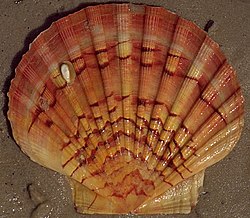Description
Pecten jacobaeus usually reaches a length of about 120–140 millimetres (4.7–5.5 in), but the world record size reaches over 210 mm. [2] The two valves have different shapes. The lower valve, with which the animal rests on the bottom, is very convex and light-colored, while the upper valve is flat and brown. They show 14 to 16 ribs (radial wrinkles) with a more or less rectangular cross section. The inside of the valves is porcelain-like smooth.
The mollusc has at the edge of the mantle many short tentacles, between which there are a total of 60 blue-millimeter lens eyes. By quickly closing of the two valves it can swim away several meters in case of danger.
These scallops eat planktonic organisms and other floating food particles, which they obtain by filtering sea water with their gills.
Distribution
This species appears to be endemic to the Mediterranean Sea, [2] but it may be conspecific with Pecten maximus , the great scallop, which has a larger distribution. [3] Although these two species are morphologically similar, they present distinguishing features. [3]
Fossils of Pecten jacobaeus first appear at the beginning of the Pliocene and are quite common in the Pliocene and Pleistocene deposits of Italy. [3]
This page is based on this
Wikipedia article Text is available under the
CC BY-SA 4.0 license; additional terms may apply.
Images, videos and audio are available under their respective licenses.


